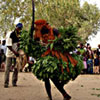 |
|
| Author |
 Topic Topic  |
|
kayjatta

2978 Posts |
 Posted - 14 May 2008 : 12:10:37 Posted - 14 May 2008 : 12:10:37


|
| Thanks for that suggestion Santafara. I think Kondorong should also take us a tour of history here. I always like his flavor of history... |
 |
|
|
tamsier

United Kingdom
557 Posts |
 Posted - 17 May 2008 : 16:32:07 Posted - 17 May 2008 : 16:32:07

|
Originally posted by Santanfar
kay we will do some thing about you? you need a decent domoda. but don't worry help is on the way. where is alpha kondo? the jatta muta jatta's. i doubt that very much. or may be not a hungry jaah taah. .our serere historian tamsier should tell us more about the movements of the serere and what names are more linked with serere. i have a friend with the names jaw. he speaks serere. is jaw a typical serere tamsier? as for you kay, you are manden. since you listen to music i suppose get some salifu keiter on Mandinkalu or old sori kandia ,mandinkalu nbalima .that track went in great lengt about who the mandens are. that is just a rehearshal. also try to lay your hand on the mandingo kingdoms of senegambia. i bought mine from canada for twenty dollar including postage. but in here we will do a casual naration. just comfirm your surname which i believe is jatta.
Santanfara,
The original homeland of the serere was what we now call futa toro. They lived their with their relatives, the tukuloor/fulani. In around 3000 BC, the time of a major climate change in the sub-sahara, many of the sereres that will become known as the serere safens and serere Nduts migrated to the sine- saloum - Bawol area. At this time, people in western Africa [as we call ourselves today] moved around due to the climate change. This is why you cannot narrate the pre-history of West Africa in particular, without taking into account the impact of climate change. Before this time for instance, the sahara desert was not a desert at all, but sea, surrounded by healthy islands. Thousands of years will pass when Almoravids, brought islam into Western Africa in particular the kingdom of Tekrur. During the reign of the revolutionist - King War Jabi 1030 - 1040 AD [son of Rabis], the king of tekrur [modern day futa toro] was converted to islam. The King wanted to make all noble sereres, tukuloors/fulani to convert. By converting the nobles, all those beneath the social strata will follow. That was the rationale. The tukuloor/fulani who had worshipped 'Dakakir' as with many of the western sudan, accepted islam and converted. The sereres on the other hand, refused to be converted. The king of Tekrur with the backing of his allies [the Almoravids] waged several wars against the sereres - [the so called infidels]. At the battle of sali, the sereres were defeated. After the king's victory, the king tried again to persuade the sereres to convert, but again, they refused. Although the Almoravids wanted conversion or death, the king stepped in by exiling the sereres from Tekrur - hence the separation between the sereres and tukuloors/fulani. As a result of that exile, the pagan sereres headed to Sine- Saloum and Bawol to join their ancient relatives. What happened in Tekrur was so unprecedented, because, although in the 9th century the Dyago Dynasty accepted islam, islam was not firmly established in tekrur and people had the right to practice their religion without intereference from the Crown. Even during the Manna Dynasty [in the 10th century], that was still the case. king War Jabi [father of Labi who would also later support the Almoravid - Abdullah Ibn Yasin]however changed all that and introduced Sharia law.
The sereres who had joined their ancient cousins established themselves in the two kingdoms of sine and saloum. They held on to their religion and tradition and used their religion to re-inforce their power. Even during the reign of sundiata Keita, the Serere were gaining control upon other states and were ruling Jolof. The Mansa Joloffing who was Serere and well known for his dark art during the reign of Sundia, will join forces with Sumanguru against Sundiata Keita at the battle of Kirina. When Sundiata sent his men to Jolof to buy horses, the Serere Mansa Joloffing ran-sacked their caravan and took all the gold as well as the horses. This will become known in history as 'the robbery of the horses'. That was the reason, why Sundiata Keita sent his cousin Mansa Tiramanghan Trawally to Jolof to kill the Mansa Joloffing. It was that defeath, if my memory serves me right which led to the subu song - in reference to 'the dark king'.
At the Battle of Turubang around 1335, some of the Manneh royal families of Gabou [modern day Guinea Bissau] - Mandinka decendants of Mansa Tiramanghan Trawally escaped the massacre and headed down to sine as royal refuges. Maissa Wally Jaxateh Manneh , commonly known in history as Maissa Wally Jon became advisors to the Serere 'Lamans' [Laman is an ancient word for king]. That council of Lamans included the noble Sarr, Faye, Joof, Sene and Ndour families. He would later acquire a huge backing after his famous judgement - and particularly backed and nominated by Laman Sarr [father of Penga Yaye Sarr] - to be recognised as king of sine. The sereres refused to have a foreing king, in fear that, their way of life and religion will be lost forever. To address the peoples concern, the Lamans from various noble families reached a deal with the Manneh royal refuges from Gabou. Maissa Wally's sisters will marry into these noble serere families and their children and children's children will rule the kingdom of sine [and later saloum]. These children will be authentic sereres, they will follow the serere religion, speak the serere language with loyalty to sine [and later saloum] and not Gabou. They will follow the matrilineal bloodline in line with serere tradition, in fact in line with many ancient African traditions. They will form the Gelwar Matrilineal Dynasty, and ancient serere noble paternal dynasties [paternal decendants of the ancient Lamans]. That was the deal before any interbreeding between serere - gelwar. This matrilineal bloodline called Gelwar -; maternal decendants of Queen Yambe Keme Gelwaro of Diaka [an old Kindom of modern day Guinea Bissau]continued to rule in sine and saloum with the paternal decendants of the ancient Serere Lamans.
So the royal families of sine and saloum - even right up to 1969 - the year the last two proper kings of sine and saloum: Mahecor Joof [of sine] and Fode Ngui joof [of saloum]died, always thought of themselves as sereres, worshipped serere Gods, spoke the serere language and adhired to serere customs and traditions. Even the inhabitans of Beytendik who always spoke Mandinka, have always preserved Serere culture and tradition as a matter of heritage.
Tekrur was ravaged by the Al-Murabitun of Almoravids in 1042 AD [two years after the death of king war jabi]. It was latter conquered by the Malian empire, and then the Jolof empire and then by the rebel Koli Tangela Bah and again by the royal family of jolof, before it gained its independence. In 1776 - at the Futa revolution, a bunch of musim cleriks invaded it and wiped out most of the royal family - [decendants of the Denyankeh dynasty]. Tafsir Amath Jahou Bah, commonly known as Maba Jahou Bah was a decendant of that bloodline. It will take years before peace is restored in that great Kingdom.
THE FOLLOWING ARE SOME SERERE NAMES WITH THEIR MEANING:
-------------------------------------------------------
Jogoye = lion
Xooxaan = one who cultivates
Biraan = whoever trait cow
Moosaan = that which is beautiful
Mosi = be beautiful
Xonik = one who will die
Geskel = that we will bury
NB: these two names [Xonik and Geskel] are used to advert bad faith. I.e. the opposite of what you want. It is a strategy especially after several infant deaths in a family.
XENAAN = elegant
Sinaan = the one that is discreet
Minaan = the one who will live for a long time
Sedar = the one who will not be humiliated
Andii = wise
Goraan = the one who is brave/courageous
Ndiig = one who is born in the rainy season
Seek = one who is born in the harvest period |
Tamsier
Serere heritage. Serere religion. Serere to the end.
Roog a fa ha. |
 |
|
|
Prince

507 Posts |
 Posted - 18 May 2008 : 01:16:26 Posted - 18 May 2008 : 01:16:26


|
| A million thanks Tamsier, that was very informative. Now,plz get that book started.... |
"When injustice becomes law, rebellion becomes duty." |
 |
|
|
Santanfara

3460 Posts |
 Posted - 18 May 2008 : 18:34:21 Posted - 18 May 2008 : 18:34:21



|
| interesting and informative. i agree with some of the narration but others are vintage tamsier |
Surah- Ar-Rum 30-22
"And among His signs is the creation of heavens and the earth, and the difference of your languages and colours. verily, in that are indeed signs for men of sound knowledge." Qu'ran
www.suntoumana.blogspot.com |
 |
|
|
tamsier

United Kingdom
557 Posts |
 Posted - 19 May 2008 : 12:27:08 Posted - 19 May 2008 : 12:27:08

|
Santanfara
What part do you think is vintage?
The surname Jaw is originally Serere, but because of interbreeding and tribal influence, it is adopted by different tribes. For example, the surname Njie which is generally thought of as Wolof is actually from Serere. The Jaw clan trace their decent to Laman Jaw - king of jolof in 1287 AD. Those that decent from him also played a key role in the election of the future kings of jolof and other wolof kingdoms [but particularly jolof] - they were members of the Jawdin, Mallo and Jogomay [Coucil of electors of the king].
|
Tamsier
Serere heritage. Serere religion. Serere to the end.
Roog a fa ha. |
 |
|
|
Santanfara

3460 Posts |
 Posted - 19 May 2008 : 13:50:11 Posted - 19 May 2008 : 13:50:11



|
| tamseir, i was told once that the serre's rulers once sacrifice a human to their Gods so that only they will be rulling over senegal. did you ever heard any story i like that? i know the serere and the wolof have a lot of commonalities but why the sacrifice and what relevance those that have to the serere history? don't mind my vintage remark ,it's just an obseravtion that tamsier kept mixing expantionist muslims with missionaries. this two have two different agendas. but since you have convince yourself otherwise lets leave that to that and concentrate on who the serere's are and what past power base they use to have. for me that is much more important. |
Surah- Ar-Rum 30-22
"And among His signs is the creation of heavens and the earth, and the difference of your languages and colours. verily, in that are indeed signs for men of sound knowledge." Qu'ran
www.suntoumana.blogspot.com |
 |
|
|
njucks
Gambia
1131 Posts |
 Posted - 20 May 2008 : 11:22:19 Posted - 20 May 2008 : 11:22:19


|
Tamsier thanks for the piece. this perhaps explains the ''Kal'' between Serers and Tukulor and i think with Jolas too.
from your text i believe Kaabunkas and Serers have something in commmon, and i would assume what the Serers would call Gelewar and what Kaabunkas call Nyanycho . and they both follow the matrilineal bloodline.
i have some question i would like to ask. you mentioned Serrer safens and serere Nduts. How many different dialects or groups of Serer are there?
also is Burr and Maad the same?
thank you.
|
 |
|
|
tamsier

United Kingdom
557 Posts |
 Posted - 20 May 2008 : 12:21:30 Posted - 20 May 2008 : 12:21:30

|
Santanfara, I must admit this is the first time I have ever heard of that [i.e. human sacrifice]. I cannot confirm whether it is true or not. However, from my understanding of serere religion and history, human sacrifice of 'ordinary people' goes against serere ancient traditions. I will explain what I mean by this later, but for now, the most impotant element in serere religion is the eco-system, to preserve their land in a healthy state and passed it down to their decendants as it was passed down to them by their ancient ancestors. Only by understanding this would you be able to understand how it links to my answer to your question - later. For example, growing certain products which can damange the eco-system, or abusing the earth and anything in it, the serere believe the ancient Pangools [ancestoral spirits] will take revenge on them by introducing locus and drought. This is one of the greatest reasons why Governfor Faidherbe [of France] had a big problem in encouraging the serere to grow ground-nuts in the serere kingdoms in the 19th century. They simply refused to grow it and it took years before a deal was reached that, they will grow it in small amounts, in designated small plots chosen by the sereres - by which time, Faidherbe had already been replaced by a new govenor. Now to answer your question, in ancient times, the Serere Lamans were treated as representative of the Gods who had the power to interceed on behalf of his people and the Pangools and Gods. Not to be confused with ancient ghana and perhaps egypt to some extend who worshipped their Kings as Gods, but the Lamans were not Gods but interceeders. Their main duty apart from running the affairs of their kingdoms were rain making and to drive out evil/desaster from their kingdom, but mainly rain-makers. This is what the ancient sereres believed. Ancient Lamans who were useless at the job - [which they should perform either through their own powers or the accumulation of charms with the assistance of their Saltigues] were physically eliminated. That means, them and their entire family would be killed by the ordinary people. Ancient Chants by the Lamans and their saltigues were recited under a Baobab tree [one of the most sacred trees in serere religion]and animal sacrifice was common and well known even hundred years ago by the Buur sine/buur saloum. Therefore, the only way an ancient serere Laman could hold on to power was by having special powers or an accumulation of charms - and ensuring rain. If he did not have the power in the first place, it would not be him who would be sacrificing someone, but he himself would be sacrificed as well as his entire family. This way of 'taking out' ineffective Lamans was changed about 670 years ago, during the Gelwar dynasty, were ineffective kings were chased out of their homes and exiled by the ordinary people. This is what happened to Fakha Boya Faal - king of Saloum [son of Damel Makodu Faal - King of Kajoor], where almost a thousand people besiged his residence and drove him out in the 19th century, making him the first king to be driven out in that humiliating fashion in over 5oo years - during his reign.
Now, even if that was true in ancient times, the serere did not have a monopoly on it, because it happened in Europe, The Americas, Asia and Africa. That was how people lived in some kingdoms. It is all good judging the morals and behaviour of the ancients with our modern eyes - without understanding their way of life in those 'yester-years'. That is how they used to live - totally different from the way we live now.
As you rightly pointed/implied the sereres and the wolofs are blood relatives just as they are related to the Tukuloors/fulas. The original homeland of the wolof was upper senegal [modern day mauritania]. They moved from there due to drought and desert raids centuries ago. They had a very ancient civilisation, it was them and and the Wagadou bloodlines of Ancient Ghana that build the tachit - walata of Modern day mauritania - [masonry with open streets and squares].
|
Tamsier
Serere heritage. Serere religion. Serere to the end.
Roog a fa ha. |
 |
|
|
tamsier

United Kingdom
557 Posts |
 Posted - 20 May 2008 : 13:02:47 Posted - 20 May 2008 : 13:02:47

|
Njuk
The Gelwars and the Nyankos/Nyanthios/Nyanychos were blood relatives. The Nyanthios were the maternal decendants of Princess Tanemba who ruled Gabou [modern day guinea bissau] with the noble paternal warrior families of sanneh and manneh. They also followed the matrilineal bloodline - which was common in Africa. One of the major reason for that was, pure blood passes through the maternal line and not the paternal line. Just as in old Wallo we had the maternal dynasties of Joos, Tedyek and Loggar, old guinea also had Nyanthio and Gelwar. It is the Nyantios who ruled loggest and had a stronger base hence the reason why more is known about them in Guinea, and hence the reason why the Gelwars are thought of as an 'off-shoot' of the Nyanthios.
-There are at least six serere dialects:
ndut,safen, noon, palor,lehar and serere-sine [the posh version].
-Buur [a wolof word] is the same as Maad/Maad sinig, they both means king.
|
Tamsier
Serere heritage. Serere religion. Serere to the end.
Roog a fa ha. |
 |
|
|
Santanfara

3460 Posts |
 Posted - 23 May 2008 : 18:32:28 Posted - 23 May 2008 : 18:32:28



|
thanks tamsier again for the elaboration. i heard of that comment a long time ago. i didn't believe in it but strange things did happen in every society's history. good that you clarify the serer mode of believes and ceremonies. it is similar with the zulus in south africa. the ancestoral spirits . i have book explaining how the zulus worship and communicate with their ancestors.
|
Surah- Ar-Rum 30-22
"And among His signs is the creation of heavens and the earth, and the difference of your languages and colours. verily, in that are indeed signs for men of sound knowledge." Qu'ran
www.suntoumana.blogspot.com |
 |
|
|
Santanfara

3460 Posts |
 Posted - 18 Jul 2008 : 22:25:56 Posted - 18 Jul 2008 : 22:25:56



|
quote:
Originally posted by tamsier
Santanfara
What part do you think is vintage?
The surname Jaw is originally Serere, but because of interbreeding and tribal influence, it is adopted by different tribes. For example, the surname Njie which is generally thought of as Wolof is actually from Serere. The Jaw clan trace their decent to Laman Jaw - king of jolof in 1287 AD. Those that decent from him also played a key role in the election of the future kings of jolof and other wolof kingdoms [but particularly jolof] - they were members of the Jawdin, Mallo and Jogomay [Coucil of electors of the king].
i forgot to ask this question, tamsier, many cultural aspects we attribute to wollofs are later found out to be serere, so what is unique to wollofs then which is has nothing to do with serere? i wa reading the allaince between lat dyor and maba. was he wollof lat dyor? |
Surah- Ar-Rum 30-22
"And among His signs is the creation of heavens and the earth, and the difference of your languages and colours. verily, in that are indeed signs for men of sound knowledge." Qu'ran
www.suntoumana.blogspot.com |
 |
|
|
Santanfara

3460 Posts |
 Posted - 18 Jul 2008 : 23:10:08 Posted - 18 Jul 2008 : 23:10:08



|
Samory Toure "Black Napoleon of the Sudan" (1830-1900)
Samory Toure, who was a conqueror from West Africa, fought the French from taking possession of his homeland for over 18 years. He fought with such mastery, that the French military leaders referred to him as "The Black Napoleon." He frustrated the Europeans to the degree that they suffered large losses of manpower and money. Samory's expert military strategy and tactics caused even greater insecurity for the French.
Samory was born of humble means, the son of a poor Black merchant and a Senegalese female slave.
Samory had become an idol of the other soldiers. Being provoked by jealousy, the king demanded Samory be removed from the army and sent back to his homeland, Bissandugu, where he became king of the tribe.
Samory's homeland was attacked by the neighboring King Sori Bourama. His mother was captured during this raid. Samory was unable to pay his mother's ransom, so he freed her by taking her place.
Samory, always desiring to be a free man, became a favorite of the king because of his splendid physique, his ability to throw a spear, and his knowledge of the Arabic language. Soon he became a bodyguard for the king, and later advanced to counselor of the tribe.
Samory defied all of his opponents and even conquered his former capturer, King Sori Bourama. Samory expanded his empire to an area of over 100,000 sq. miles or more, making him the most powerful native ruler in West Africa.
On September 29, 1898, while Samory was on his knees, outside of his tent praying. A French sergeant, and a French scout, crept upon him from behind, captured and exiled him to an island for life.
culled from africa within |
Surah- Ar-Rum 30-22
"And among His signs is the creation of heavens and the earth, and the difference of your languages and colours. verily, in that are indeed signs for men of sound knowledge." Qu'ran
www.suntoumana.blogspot.com |
 |
|
|
Janyanfara

Tanzania
1350 Posts |
 Posted - 19 Jul 2008 : 02:30:15 Posted - 19 Jul 2008 : 02:30:15


|
Hi fellows,
This is indeed an interesting topic
But first I want to ask?
Does manding history started when Dankaran Touman,Nana Turubang,Sundiata,Manding Bory sugulung kulunkang ect ect came to the spotlight or well before their parents?
I think history of manding started well before Sasuma Berete was even born though much was not known but Manding history was dated well back before even the great Sumanguru overpowered the mandingos under Sundiata's father.According to tradition,Sumanguru conquered manding because of vengence he had when his tribe was conquered at the battle of buluntada and also to make sure the mandingoes were no longer a threat to his people ever again.
The even happened then Sumanguru was a boy and Marijata(Sundiata) was not even born.The Mandingoes were then in existance and hd their small chieftains though independance of each other.
Most historians tend to trace manding history from Sundiata then one of his generals Tramakang who most Nyanchos traced their oregin from.But what about the tradition of the misterious women called Balaba,Falaku and tinkida?
I shall stop here for a while.
To be continued...... |
Edited by - Janyanfara on 19 Jul 2008 02:34:47 |
 |
|
|
Santanfara

3460 Posts |
 Posted - 19 Jul 2008 : 02:48:43 Posted - 19 Jul 2008 : 02:48:43



|
interesting janyanfara. manden history go well before sundiata. but he was the one who uplifted the people to the statue they held for a long period. the epic you narrate are very interesting. i hope ypu dwell on them further. are you a susu man janyanfara? you seem to have a soft spot for susu sumanguru the sorcerer king. |
Surah- Ar-Rum 30-22
"And among His signs is the creation of heavens and the earth, and the difference of your languages and colours. verily, in that are indeed signs for men of sound knowledge." Qu'ran
www.suntoumana.blogspot.com |
 |
|
|
kaanibaa

United Kingdom
1169 Posts |
 Posted - 19 Jul 2008 : 02:50:17 Posted - 19 Jul 2008 : 02:50:17


|
| Tamsier I would be one of those queuing to buy your book so go on write one please!Your writings are so thorough and I dear say very good reading material for those interested in the history of our sub region.Thanks for your postings I enjoyed reading them so much,barkeh fapes you are good. |
 |
|
 Topic Topic  |
|
|
|
| Bantaba in Cyberspace |
© 2005-2024 Nijii |
 |
|
|

